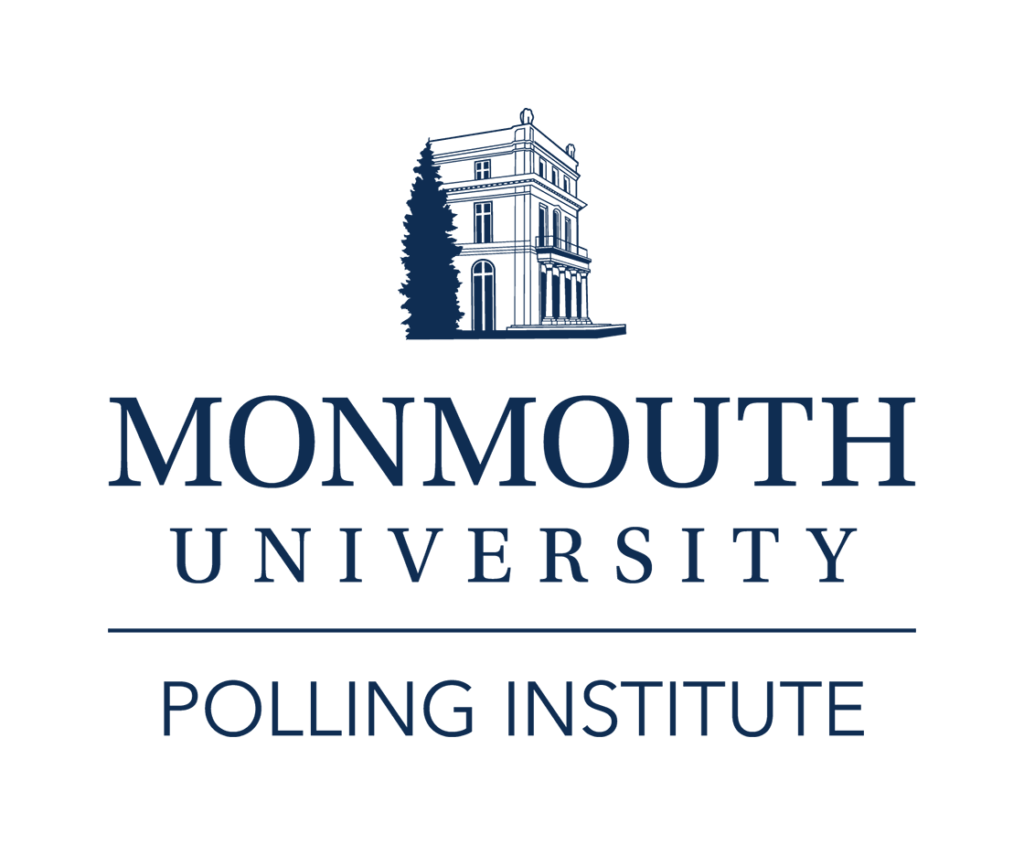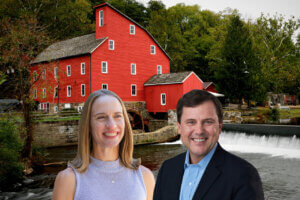Hillary Clinton and Rudy Giuliani maintain sizable leads in their parties’ respective New Jersey presidential primary contests, according to the latest Monmouth University/Gannett New Jersey Poll. The poll also found that these two front-runners are the candidates who voters from the opposite party fear the most in a general election match-up.
Among likely Democratic primary voters in New Jersey, Clinton currently claims support from 42% of voters, compared to 23% for Barack Obama and 7% for John Edwards. Other candidates poll in the single digits. In an April 2007 poll, the race stood at a similar 41% for Clinton, 22% for Obama and 13% for Edwards.
On the Republican side, Giuliani claims support from 44% of likely GOP primary voters, compared to 12% for John McCain, 10% for Fred Thompson, and 8% for Mitt Romney. Other candidates poll in the single digits. In April, the race stood at 49% for Giuliani, 19% for McCain and 6% for Romney. Thompson was not an official candidate then and it appears his entrance into the race took a small amount of support equally from Giuliani and McCain.
The poll also asked primary voters which candidate they thought would make the strongest general election nominee for the opposite party. Among Democratic primary voters, Rudy Giuliani is seen as the man to beat – 44% say he would pose the toughest challenge to a Democratic nominee. Fewer Democratic voters see McCain (15%), Romney (6%), and Thompson (5%) as the top Republican threat. Another 10% volunteer that no one in the current Republican field will pose a challenge in the general election.
Across the aisle, half of Republican primary voters say Hillary Clinton (49%) would be the hardest Democrat to beat in November ’08. About 1-in-4 (24%) see Obama as the toughest challenge to a GOP victory and 9% say the same for Edwards. Another 5% volunteer that no one in the current Democratic field will pose a challenge in the general election.
“If the presidential nominations go the way New Jersey stands right now, each party will be fielding the candidate feared most by the rank and file of the opposite party,” commented Patrick Murray, director of the Monmouth University Polling Institute.
The situation in Iraq continues to be a top issue weighing on Garden State voters’ minds. However, it ranks just slightly ahead of concerns about health care coverage and prescription drug costs. Specifically, 51% of registered voters in New Jersey want to hear the presidential candidates address what they would do about the war in Iraq, and nearly that number (45%) say the same about their plans for health care. Other issues that concern voters include the economy and jobs (20%), immigration (10%), homeland security (9%), and federal taxes (8%).
The importance of these issues has remained basically unchanged since the April poll, with one important exception. Six months ago, only 23% of New Jersey voters named health care as a top issue in the presidential race. That number has nearly doubled to 45% now, including 54% of Democrats, 34% of Republicans, and 42% of independents who name it as a top concern.
Murray remarked, “Health care is emerging as possibly the most important ‘swing’ issue in next year’s presidential campaign.”
The Monmouth University/Gannett New Jersey Poll was conducted by telephone with 1091 New Jersey registered voters from September 27 to 30, 2007. The total sample has a margin of error of ± 3.0 percent. The margins of error for the two voting intention questions are ± 4.5% for the 478 likely Democratic primary voters and ± 4.8% for the 411 likely Republican primary voters. The poll was originally published by the Gannett New Jersey newspaper group (Asbury Park Press, Courier-Post, Courier News, Daily Journal, Daily Record, Home News Tribune, and Ocean County Observer).
A note on the primary sample methodology:
Most New Jersey voters have not had the opportunity to vote in a competitive presidential primary due to the fact that the state’s contests have been held in June, after the eventual nominees had been all but determined. Turnout in the 2004 primary was 10% of all voters or about 22% of registered Democrats and Republicans. Turnout in 2000 was slightly higher at 17% overall, or 39% of registered Democrats and 35% of registered Republicans. However, the 2000 primary also included contested U.S. Senate races in both parties. Moreover, unaffiliated voters are able to vote in either party’s nomination contest on primary day. As such, it is difficult to predict potential turnout for the February 2008 presidential primary. The sample used for this survey involved a random digit dial (RDD) sample of 688 registered voters plus an additional sample of 403 known past primary voters drawn from voter record lists. Subsets of likely voters for each party’s primary were asked the voting intention questions. Responses from the RDD and list-based samples were given equal weight for those questions.
DATA TABLES
The questions referred to in this release are as follows:
(* Some columns may not add to 100% due to rounding.)
1. [ASKED OF LIKELY DEMOCRATIC PRIMARY VOTERS:] I’m going to read a list of people running for the Democratic nomination. After I read it, please tell me who you would vote for if the primary were held today. [Names were rotated]
|
Democrats | Likely Primary Voters | Known Past Primary Voters Only |
GENDER | |
|
Male |
Female | |||
| Hillary Clinton | 42% | 34% | 41% | 43% |
| Barack Obama | 23% | 22% | 24% | 22% |
| John Edwards | 7% | 6% | 7% | 7% |
| Bill Richardson | 1% | 2% | 1% | 1% |
| Joe Biden | 2% | 2% | 4% | 1% |
| Chris Dodd | 0% | 1% | 0% | 0% |
| Dennis Kucinich | 2% | 2% | 3% | 1% |
| Mike Gravel | 0% | 0% | 0% | 0% |
| (VOL) Al Gore | 1% | 0% | 1% | 0% |
| Don’t know | 21% | 31% | 18% | 23% |
| Unwtd N |
478 | 201 | 213 |
265 |
| TREND: |
Sept. |
April |
| Hillary Clinton | 42% | 41% |
| Barack Obama | 23% | 22% |
| John Edwards | 7% | 13% |
| Bill Richardson | 1% | 2% |
| Joe Biden | 2% | 3% |
| Chris Dodd | 0% | 0% |
| Dennis Kucinich | 2% | 0% |
| Mike Gravel | 0% |
n/a |
| (VOL) Al Gore | 1% | 1% |
| Don’t know | 21% | 18% |
| Unwtd N |
478 |
451 |
2. [ASKED OF LIKELY DEMOCRATIC PRIMARY VOTERS:] Now thinking about the Republican field. Who would make the strongest Republican nominee, that is the hardest for a Democrat to beat in November 2008, is it – [Names were rotated]?
| Democrats |
Likely | Known Past Primary Voters Only |
GENDER | |
|
Male |
Female | |||
| Rudy Giuliani | 44% | 41% | 47% | 42% |
| John McCain | 15% | 11% | 17% | 14% |
| Mitt Romney | 6% | 7% | 7% | 6% |
| Fred Thompson | 5% | 4% | 4% | 6% |
| (VOL) None are strong | 10% | 10% | 9% | 11% |
| Don’t know | 18% | 26% | 16% | 20% |
| Unwtd N |
478 | 201 | 213 | 265 |
3. [ASKED OF LIKELY REPUBLICAN PRIMARY VOTERS:] I’m going to read a list of people running for the Republican nomination. After I read it, please tell me who you would vote for if the primary were held today. [Names were rotated]
|
Republicans | Likely Primary Voters | Known Past Primary Voters Only |
GENDER | |
|
Male |
Female | |||
| Rudy Giuliani | 44% | 41% | 43% | 46% |
| John McCain | 12% | 8% | 11% | 14% |
| Mitt Romney | 8% | 11% | 8% | 9% |
| Fred Thompson | 10% | 12% | 12% | 8% |
| Sam Brownback | 0% | 0% | 0% | 0% |
| Mike Huckabee | 2% | 2% | 2% | 1% |
| Ron Paul | 1% | 1% | 3% | 0% |
| Duncan Hunter | 0% | 0% | 0% | 0% |
| Tom Tancredo | 1% | 1% | 3% | 0% |
| (VOL) Other | 1% | 0% | 1% | 1% |
| Don’t know | 20% | 24% | 18% | 22% |
| Unwtd N |
411 | 202 | 192 |
219 |
| TREND: |
Sept. |
April |
| Rudy Giuliani | 44% | 49% |
| John McCain | 12% | 19% |
| Mitt Romney | 8% | 6% |
| Fred Thompson | 10% | 1%* |
| Sam Brownback | 0% | 1% |
| Mike Huckabee | 2% | 1% |
| Ron Paul | 1% |
n/a |
| Duncan Hunter | 0% |
n/a |
| Tom Tancredo | 1% |
n/a |
| Don’t know | 20% | 21% |
| Unwtd N |
411 |
451 |
[ * Fred Thompson was a voluntary response in the April 2007 poll]
4. [ASKED OF LIKELY REPUBLICAN PRIMARY VOTERS:] Now thinking about the Democratic field. Who would make the strongest Democratic nominee, that is the hardest for a Republican to beat in November 2008, is it – [Names were rotated]?
|
Republicans | Likely Primary Voters | Known Past Primary Voters Only |
GENDER | |
|
Male |
Female | |||
| Hillary Clinton | 49% | 53% | 51% | 47% |
| Barack Obama | 24% | 19% | 21% | 27% |
| John Edwards | 9% | 9% | 12% | 7% |
| (VOL) None are strong | 5% | 5% | 8% | 3% |
| Don’t know | 12% | 16% | 8% | 16% |
| Unwtd N |
411 | 202 | 192 |
219 |
5. [ASKED OF ALL REGISTERED VOTERS:] In your opinion, what are the most important one or two issues that the candidates for president should talk about? [Note: Results do not add to 100% because multiple responses were accepted]
|
All | Likely Primary Voters | Known Past Primary Voters Only |
PARTY ID | |||
|
Dem | Ind |
Rep | ||||
| War in Iraq | 51% | 52% | 54% | 58% | 50% | 45% |
| Health care and prescription drug costs | 45% | 46% | 44% | 54% | 42% | 34% |
| Economy/ Jobs/ Cost of living | 20% | 20% | 19% | 20% | 21% | 19% |
| Immigration | 10% | 10% | 10% | 4% | 13% | 16% |
| Terrorism/ Homeland security | 9% | 11% | 12% | 5% | 6% | 19% |
| Foreign policy/ foreign relations | 4% | 3% | 3% | 2% | 6% | 4% |
| Federal/Income Taxes | 8% | 7% | 7% | 4% | 11% | 11% |
| State (Property) Taxes | 6% | 6% | 6% | 4% | 7% | 7% |
| Social security | 5% | 6% | 6% | 5% | 5% | 6% |
| Education/ schools | 6% | 6% | 6% | 8% | 6% | 5% |
| Environment/ global warming | 3% | 3% | 3% | 5% | 1% | 2% |
| Abortion/ gay marriage/ morality/ stem cells/ social issues | 3% | 3% | 3% | 3% | 2% | 4% |
| Gas prices | 1% | 1% | 0% | 1% | 2% | 1% |
| Budget deficit | 4% | 3% | 5% | 3% | 3% | 5% |
| Ethics/ corruption/ cleaning up government | 3% | 2% | 3% | 1% | 3% | 5% |
| Other | 2% | 2% | 2% | 2% | 2% | 2% |
| Nothing/ Don’t know | 5% | 3% | 3% | 3% | 6% | 4% |
| Unwtd N |
1091 | 889 | 403 | 443 | 262 |
369 |
| TREND: |
Sept. |
April |
| War in Iraq | 51% | 52% |
| Health care and prescription drug costs | 45% | 23% |
| Economy/ Jobs/ Cost of living | 20% | 19% |
| Immigration | 10% | 8% |
| Terrorism/ Homeland security | 9% | 9% |
| Foreign policy/ foreign relations | 4% | 5% |
| Federal/Income Taxes | 8% | 13% |
| State (Property) Taxes | 6% | 5% |
| Social security | 5% | 5% |
| Education/ schools | 6% | 8% |
| Environment/ global warming | 3% | 5% |
| Abortion/ gay… stem cells/ social issues | 3% | 3% |
| Gas prices | 1% | 1% |
| Budget deficit | 4% | 3% |
| Ethics/ corruption/ cleaning up government | 3% | 3% |
| Other | 2% | 4% |
| Nothing/ Don’t know | 5% | 7% |
| Unwtd N |
1091 |
1069 |
The Monmouth University/Gannett NJ Poll was designed and analyzed by the Monmouth University Polling Institute research staff. The telephone interviews were conducted by Braun Research on September 27-30, 2007 with a statewide random sample of 1,091 registered voters. For results based on the total sample, one can say with 95% confidence that the error attributable to sampling has a maximum margin of plus or minus 3.0 percentage points. The sample used for this survey involved a random digit dial sample of 688 registered voters plus an additional sample of 403 known past primary voters who were drawn from voter records. Sampling error increases as the sample size decreases, so statements based on various population subgroups, such as separate figures reported by gender or party identification, are subject to more error than are statements based on the total sample. In addition to sampling error, one should bear in mind that question wording and practical difficulties in conducting surveys can introduce error or bias into the findings of opinion polls.
Click on pdf file link below for full methodology and results by key demographic groups.




